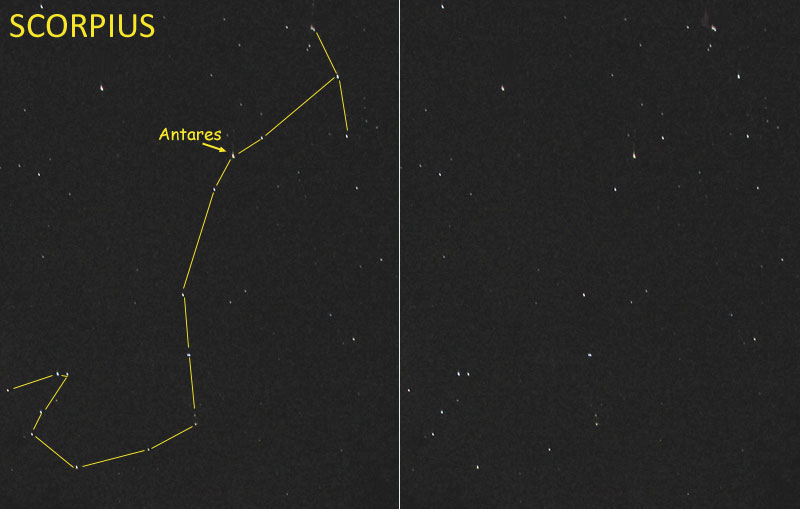Excerpts from Jim Conrad's
Naturalist Newsletter
from the March 20, 2016 Newsletter issued from Hacienda Chichen Resort beside Chichén Itzá Ruins; limestone bedrock; elevation ~39m (~128ft), N20.675°, W88.569°; central Yucatán state, MÉXICO
SCORPIUS AT DAWN
During my pre-dawn jog as I head east, if it isn't cloudy or foggy, the sky is dominated by one of the most clearly delineated of all constellations, that of Scorpius, The Scorpion. One morning this week the stars shined so brilliantly that during the jog I took along my camera. At a certain spot on the road where the sky was open I lay on the pavement, positioned my camera on some rocks so that it pointed at an angle into the sky, set the shutter speed to 15 seconds, and photographed Scorpius's part of the sky. Below, you can see the result shown twice, with the image on the left outlining Scorpius's form and highlighting the most brilliant and best known star in the constellation -- Antares:

Something missing in the photos, but which was very apparent to me that morning, even with my dimmed vision, is the Milky Way, which on clear nights glows like a slender luminous cloud cutting across the sky from horizon to horizon, and passing through Scorpius's tail and stinger. On the outline, Scorpius's tail is at the bottom, left, and the head and pincers at the top, right.
Scorpius is a well known constellation. One reason is that it's one of the twelve constellations of the zodiac -- the zodiac being the path of the Sun and Moon across the sky. As such, Scorpius is considered by astrologists to exercise much power in people's lives.
Also, with its tail in the Milky Way, Scorpius is well known as home to many interesting deep-space objects. Remember that the Milky Way is the view we see when we look across our own galaxy. Our galaxy is shaped like a thin disk. If we look skyward in a direction perpendicular to the disk-galaxy's wideness, our vision passes through our galaxy's limited thickness and we see relatively few, relatively nearby stars. If we look skyward in a direction taking our eyes across the galaxy's broadness, we see so many distant stars that all together they look like a pale cloud, and that's the Milky Way. You might enjoy Wikipedia's Scorpius page where the constellation's most important celestial features are cataloged, at https://en.wikipedia.org/wiki/Scorpius.
The best known star in the constellation Scorpius is Antares, the fifteenth brightest star in the whole nighttime sky, and the brightest in Scorpius. Sometimes Antares is thought of as The Scorpion's heart. It's about 550 light years from Earth and is described as a red super-giant, with a radius about 883 times that of our Sun.
When I'm running, looking at Scorpius, the constellation so obviously looks like a scorpion that I like to remember that not all cultures, even those who know scorpions very well, see a scorpion there. Javanese people, for example, see a swan, or sometimes a leaning coconut tree.
However, I haven't heard of any culture that doesn't see something in that curving line of stars. Our human brains just have to look for patterns, and invent stories to fit the patterns.